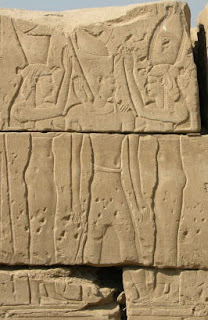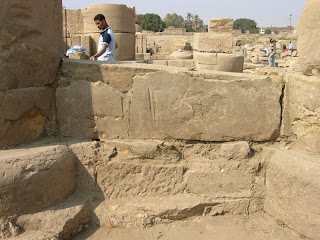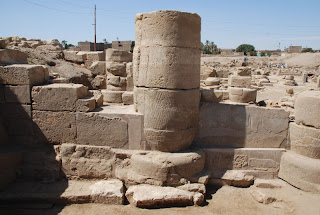 Hatshepsut being crowned by Amun-Re and granted life and dominion by the goddess "Great in Magic", from the reconstructed Red Chapel in the Karnak Open Air Museum. An early 18th Dynasty temple at Mut dates to the reign of this woman who ruled as king.
Hatshepsut being crowned by Amun-Re and granted life and dominion by the goddess "Great in Magic", from the reconstructed Red Chapel in the Karnak Open Air Museum. An early 18th Dynasty temple at Mut dates to the reign of this woman who ruled as king. "God's Wife of Amun" was an important female priestly title in Thebes. In the 1st millennium BC it was usually held by a sister or daughter of the reigning king, each God's Wife adopting her successor. They became so powerful that they were able to have themselves represented in roles normally played by the king.
 In scenes of goddesses suckling humans, the human is normally the king, with the scene representing the transfer of life and power. Yet in this scene in the Chapel of Osiris-Ruler-of-Eternity at Karnak, not only is the God's Wife of Amun, Shepenwepet I, being suckled, she is also wearing 2 Double Crowns, something shown nowhere else in any period.
In scenes of goddesses suckling humans, the human is normally the king, with the scene representing the transfer of life and power. Yet in this scene in the Chapel of Osiris-Ruler-of-Eternity at Karnak, not only is the God's Wife of Amun, Shepenwepet I, being suckled, she is also wearing 2 Double Crowns, something shown nowhere else in any period.
 In her funerary chapel at the temple of Medinet Habu, Amunirdis makes offerings to Amun and Hathor. The presence of funerary chapels to mortals within the sacred grounds of a temple is rare until the Third Intermediate Period, a time when God's Wives of Amun flourished.
In her funerary chapel at the temple of Medinet Habu, Amunirdis makes offerings to Amun and Hathor. The presence of funerary chapels to mortals within the sacred grounds of a temple is rare until the Third Intermediate Period, a time when God's Wives of Amun flourished.
 Intangible concepts could also be represented as goddesses. In a scene commemorating an important military campaign by Sheshonq I of Dynasty 22, the goddess "Victorious Thebes", carrying a mace, an axe and a bow, drags conquered cities (shown as bound prisoners with the city names enclosed in cartouches representing fortified walls) to be slaughtered.
Intangible concepts could also be represented as goddesses. In a scene commemorating an important military campaign by Sheshonq I of Dynasty 22, the goddess "Victorious Thebes", carrying a mace, an axe and a bow, drags conquered cities (shown as bound prisoners with the city names enclosed in cartouches representing fortified walls) to be slaughtered.
 Upper and Lower Egypt were represented as the goddesses Nekhbet (right) and Wadjet. Scenes of the king flanked by these protective deities are common in all periods of Egyptian history. This one comes from the Mut Precinct's Ptolemaic Chapel D.
Upper and Lower Egypt were represented as the goddesses Nekhbet (right) and Wadjet. Scenes of the king flanked by these protective deities are common in all periods of Egyptian history. This one comes from the Mut Precinct's Ptolemaic Chapel D. Keeping Mut and Sakhmet happy was a main function of the Mut priesthood. In this scene from the Mut Precinct's main entrance the king (holding Hathor-headed sistra) and two priestesses play music to Mut and Sakhmet to amuse them and keep them contented.
Keeping Mut and Sakhmet happy was a main function of the Mut priesthood. In this scene from the Mut Precinct's main entrance the king (holding Hathor-headed sistra) and two priestesses play music to Mut and Sakhmet to amuse them and keep them contented.
Two busts of Sakhmet in the Mut Precinct. Sakhmet angered could release disease and disaster on Egypt. Contented she could control these forces, which is why she is a goddess of health and healing as well as of death and destruction.



These 3 reliefs of Mut span a period of several hundred years. On the left is a relief from Amunirdis's funerary chapel at Medinet Habu; in the center a relief from the chapel of Osiris-Ruler-of-Eternity at Karnak; and on the right a relief in Chapel D at the Mut Precinct. In all three scenes Mut appears in her usual guise of a human wearing the Double Crown.
 And finally, a stela of a king offering to Mut that we uncovered in 2006. While the stela is uninscribed, it is entirely possible that it dates to the reign of the Roman Emperor Tiberius, showing that Mut continued as an important goddess even after Egypt's conquest by Rome.
And finally, a stela of a king offering to Mut that we uncovered in 2006. While the stela is uninscribed, it is entirely possible that it dates to the reign of the Roman Emperor Tiberius, showing that Mut continued as an important goddess even after Egypt's conquest by Rome.Richard Fazzini
Director, Mut Expedition







 The east wing of the
The east wing of the 





 This photo was taken from the north enclosure wall and shows all of the Temple A Forecourt and area north of
This photo was taken from the north enclosure wall and shows all of the Temple A Forecourt and area north of 
 We finally moved the fallen
We finally moved the fallen 

 The pieces of
The pieces of 
 The 6 largest
The 6 largest  We said good-bye to Bill and Elsie Peck earlier this week. Elsie is our indefatigable recorder and artist. You see her here as she is usually found at the site, surrounded by workmen and taking careful notes of the work in progress. We could not function without her skills and, even more important, her patience, cheerfulness and determination to get things right.
We said good-bye to Bill and Elsie Peck earlier this week. Elsie is our indefatigable recorder and artist. You see her here as she is usually found at the site, surrounded by workmen and taking careful notes of the work in progress. We could not function without her skills and, even more important, her patience, cheerfulness and determination to get things right. Here is Bill (our master draughtsman) with our Egyptian colleagues and friends on the last full day of work. Without them the expedition would not be possible: our foreman,
Here is Bill (our master draughtsman) with our Egyptian colleagues and friends on the last full day of work. Without them the expedition would not be possible: our foreman, 


 The inner (top) and outer faces of the porch at the end of the season. The foundations are firm, voids where stone had rotted away have been filled, and the intercolumnar wall is once again a single block.
The inner (top) and outer faces of the porch at the end of the season. The foundations are firm, voids where stone had rotted away have been filled, and the intercolumnar wall is once again a single block.

 Once the chapel was finished we could put the ram on its new base. It isn't very big, but granite is heavy and awkward to move, even with a siba.
Once the chapel was finished we could put the ram on its new base. It isn't very big, but granite is heavy and awkward to move, even with a siba. With the ram in place we could finally re-attach its left foreleg and Mohammed could begin to fill in the missing areas.
With the ram in place we could finally re-attach its left foreleg and Mohammed could begin to fill in the missing areas. The ram at the end of this week - a great improvement.
The ram at the end of this week - a great improvement. 



 The entrance and first room of Chapel D showing the results of our work in the 2006 and 2007 seasons.
The entrance and first room of Chapel D showing the results of our work in the 2006 and 2007 seasons. Chapel D will continue to be a focus of next season's conservation efforts. The walls of the inner rooms of the chapel are very badly decayed. This year we were able to shore them up temporarily, but they have to be dismantled and rebuilt.
Chapel D will continue to be a focus of next season's conservation efforts. The walls of the inner rooms of the chapel are very badly decayed. This year we were able to shore them up temporarily, but they have to be dismantled and rebuilt.

 Lisa and her conservation team with the revived ram. Thursday was Lisa's last day at the site and we will miss her. Despite sandstorms, occasional shortages of materials, and the challenges of on-site conservation she was able to maintain her sense of humor and her thorough professionalism. Thanks Lisa!
Lisa and her conservation team with the revived ram. Thursday was Lisa's last day at the site and we will miss her. Despite sandstorms, occasional shortages of materials, and the challenges of on-site conservation she was able to maintain her sense of humor and her thorough professionalism. Thanks Lisa! 
